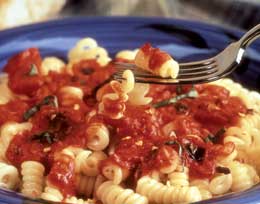
In terms of sales, pasta registers a strong $6 billion annually, representing a steady growth of 12% in current prices from 1997 to 2001. However, a look at inflation-adjusted sales shows only a 2% increase. Between 1999 and 2001, frozen pasta dinners/entrées, shelf-stable pasta and dry pasta combined to register an average growth of 8%, a telling statistic considering these three segments comprise more than 90% of the market. Frozen pasta dinners/entrées and shelf-stable pastas, in particular, posted significant sales increases during that three-year span. Sales of shelf-stable pastas grew 7.2%, while frozen dinners/entrées posted an 11.5% gain.
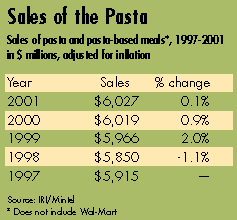
Getting Fresh
New product development in the last several years “focused on fresher pasta, more conveniently prepared items in a variety of flavors and forms,” says Mintel. Furthermore, organically grown and flavored pastas each have targeted niche consumer markets. Consumers have shifted their preferences in favor of frozen prepared meals and shelf-stable pasta products over refrigerated and frozen pasta, perhaps a reflection of the wider trend toward home meal replacement products. Consumers may regard shelf-stable pasta (not canned, Mintel notes) as a better balance of convenience and ease/speed of preparation than what frozen pasta offers.Some 96% of households consume pasta, according to Simmons' (New York) National Consumer Survey (NCS), with 93% favoring dry pasta. Complete packaged dinners and mixes registered a distant second (63%), followed by canned/jarred pasta (59%). However, these usage patterns are not carved in stone, as 96-97% of households consuming either complete packaged dinners/mixes or canned/ jarred pasta also use dry packaged pasta.
Pasta consumption is more likely in households with children, where usage is particularly high for complete packaged dinners/mixes (73% in households with children, as opposed to 57% of those without) and canned/jarred pasta (69% of households with children versus 53% of those without). Shelf-stable pasta, such as Campbell Soup's (Camden, N.J.) Franco American SpaghettiOs and ConAgra's (Omaha, Neb.) Chef Boyardee Beefaroni, is popular among demographic groups, especially as lunch or after-school snacks for children.
Furthermore, several studies have shown U.S. consumers are eating more meals at home. While reflecting any of a variety of socio-cultural and economic factors, this trend could prove positive for pasta and pasta-based meal products. Considering 71% of respondents to Mintel research say they do not have enough time in the day, the convenience inherent in many such pasta-based meals could bode well for the segment and for the category as a whole.
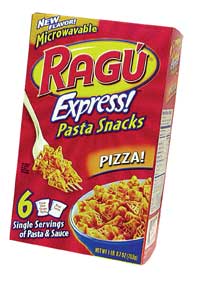
Pasta Segments
Leading the way in the frozen dinner/entrée segment of the pasta market is Nestle's (Glendale, Calif.) broad range of products. The only manufacturer to have achieved sales growth in this sector between 1999 and 2001, Nestle's success is due primarily to the success of its new Lean Cuisine varieties.
Sales of shelf-stable pasta products had no such bright spot, declining 4% over the review period despite a slight recovery in 2000 before dropping again in 2001. Canned foods, Mintel notes, often suffer from negative consumer perceptions, and considering these are competing with an increasing number of fresh, refrigerated and frozen alternatives, sales are expected to remain relatively level through 2005. ConAgra Foods dominates this segment, boasting 51.4% despite declining slightly since 1999. Kraft's (Glenview, Ill.) It's Pasta Anytime! brand may be set to commandeer a significant portion of that segment, however. In addition, General Mills (Minneapolis) continues to grow sales of its Betty Crocker-branded products and also could prove a thorn in ConAgra's side in this segment.
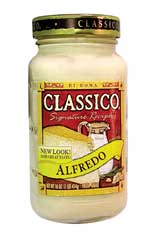
The dry pasta segment has seen a number of introductions in the dry pasta dinner area. Campbell's Supper Bakes, Banquet's Homestyle Bakes and Lipton's (Englewood Cliffs, N.J.) Sizzle & Stir meal kits aim to offer consumers convenient family-style meals. However, some introductions have targeted children who want to make their own meals. Unilever Bestfoods' (Englewood Cliffs, N.J.) Ragu Express and Kraft Easy Mac are just two such examples. Such products also benefit from parents seeking more healthful snacks.
Dropping by 14% in real terms, fresh/refrigerated pasta has benefited from new product introductions but has been unable to fend off the competition from frozen meal kits and other frozen prepared meals. Filled pasta has been the most pronounced trend in this segment, with fillings ranging from such traditional offerings as meat, cheese, vegetables and mushrooms to such additions as snow crab, lobster, feta cheese and spinach, and grilled chicken Dijon.
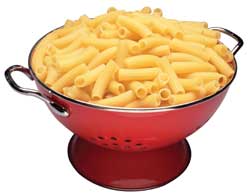
Mintel sees several factors that should drive sales through 2006. Consumers are moving to cooking and entertaining at home, thereby presenting an opportunity for pasta meals. Convenience and ease of preparation are both readily apparent in many pasta products. On the other hand, working against the market could be the decline in the number of households with children and the industry's lack of emphasis on the healthful benefits of pasta.
For more information on the report mentioned in this article, “The U.S. Pasta Market,” contact Mintel International Group Ltd.; 213 W. Institute Place, Suite 208; Chicago, IL 60610; phone: 312-932-0400.
Website Resources
www.mintel.com— Mintel International Groupwww.ilovepasta.org— National Pasta Association www.PreparedFoods.com/archives/2002/2002_6/0602secrets.htm — Pasta sauces worldwide from Prepared Foods
